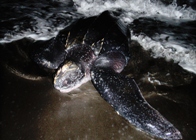Leatherback turtles tracked by satellite

One of the leatherback turtles coming ashore on Dominic
31 May 2007
Thursday 31 May, 2007
Leatherback turtles tracked by satellite
Scientists from Aberystwyth have just returned from the Caribbean island of the Commonwealth of Dominica where they have been tagging giant leatherback sea turtles as part of an international study of this endangered species.
Marine biologists Dr John Fish and Mr Rowan Byrne from the Institute of Biological Sciences at Aberystwyth are using the latest satellite tracking technology to study the nesting behaviour and post nesting behaviour of leatherback turtles in the eastern Caribbean.
Female leatherback turtles, measuring up to 2 metres in length and a tonne in weight, attempt to nest every three years between March and August nesting at about10 day intervals. During this time they will deposit around 70 to 100 eggs in each nesting.
It is this behaviour, the choice of beach, where they travel to in between laying, and the distances involved, which provide the focus for the Aberystwyth study, and the basis for a turtle recovery plan in the island.
Dr John Fish said:
“After securing the necessary licenses from the Dominican Government, which involved a meeting Prime Minister Roosavelt Skerrit, we were able to proceed with the satellite tagging. Satellite Relay Data Loggers were attached to two turtles, named Doris and Mabel, after they came ashore to lay eggs on Rosalie Beach on the east coast of the island. Directly attached to the hard outer shell, the data loggers will record their every movement for the next 9 to 12 months before being naturally discarded as their shells expand, causing the attachments to give away.”
“We know from external identification tags that both turtles have already nested on Dominica earlier this year but we expect more nesting activity and wait with interest to see if the turtles return to Dominica, and indeed the same beach, to lay again before migrating out to the feeding grounds in the north Atlantic.
“In the short time since they were tagged, the first turtle (Doris) has stayed close to the shore of Dominica moving no further than 40km offshore. The second turtle (Mabel) has been much more active travelling up to 75km offshore and diving to depths of 420m. This is the first time that nesting leatherbacks have been satellite tracked off Dominica and each day provides valuable information on this endangered species. At the end of their nesting activity they will begin their feeding migrations and who knows, we might find that Doris and Mabel are feeding on the shoals of jellyfish off the Welsh coast” he added.
Further information about the project and regular updates on the movements of Doris and Mabel are provided on http://www.aber.ac.uk/biology/prospective/seaturtles_tmp.html.
MSc student Rowan Byrne spent four years managing the sea turtle project in Dominica, working with national Government ministries.
“The Commonwealth of Dominica has recognised the importance of leatherback turtles and we very much hope that this study will contribute to building the island's reputation as a leading centre for conservation and eco tourism.”
Dominica
Dominica is located in the eastern Caribbean, between the French Islands of Guadeloupe (to the north) and Martinique (to the south) and is sparsely populated with around 70,000 people inhabiting its 289.5 square miles. A significant portion of the population lives in and around the capital city, Roseau and two thirds of the island's rugged terrain is covered by tropical forest.
Leatherback Turtles
The Leatherback Sea Turtle (Dermochelys coriacea) is the biggest of all living turtles, reaching a length of over 2.7 m (8.8 ft) and weighing up to a tonne. It is the world's fourth largest reptile, behind the larger crocodiles. The Leatherback Sea Turtle is found in all tropical and subtropical oceans, and its range has been known to extend well into the Arctic Circle. It is the only extant species in the genus Dermochelys and the family Dermochelyidae. Life expectancy can be anything between 50 and 70 years.
In recent years numbers have declined rapidly. A study on the Pacific coast in 1980 indicated a population of 135,000. A similar survey of the same coastline in 2000 indicated a population of 20,000 – a drop of 80%. Similar falls in population have been registered in the Philippines. The principal causes for deaths are driftnets and long line fishing, and debris such as plastic bags which they confuse with jellyfish, their principal source of food. Natural predators include orca, the white shark and the tiger shark.
Leatherback turtles nest every three years. Over a period of about 6 months they will lay batches of up to 70 eggs at 10 day intervals averaging 6 to 7 nests in a season. They are regionalized nesters and can be very selective when looking for potential nesting sites as they prefer high energy wave exposed beaches. Well oxygenated sand is needed as the nests are 75cm deep. Nesting takes 2 to 2.5 hours, with digging the body pit taking 30 to 40 minutes. The incubation period for the eggs is 65 – 75 days, the eggs laid on 10 May should hatch around 10 July. Turtles provide no parental care and only 1 in 1000 will make it through to adulthood.
After the egg laying season leatherback turtles migrate in search of food to the north Atlantic, off the Canadian coast and northern Europe. Swimming at 5 to 6 kph, 1.8m below the surface, they follow drifting jellyfish and can travel up to 10,000 kms over a period of 18 months. The density of jellyfish off the west Wales coast during the summer months provides ideal foraging grounds for attracting leatherback turtles.
The largest leatherback on record was a male stranded off the Welsh coast in 1988. He weighed 916kg. If Doris and Mabel, who weigh around half a tonne each, do migrate to Welsh waters they are likely to arrive sometime during November or December.



